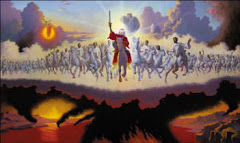"... Christ our passover is sacrificed for us..." 1
Corinthians 5:7
"And the blood
shall be to you for a token upon the houses where ye are: and when I see the
blood, I will pass over you, and the plague shall not be upon you to destroy
you, when I smite the land of Egypt." Ex. 12:13.
This applies to
Christians in 2013. Just as the Passover was instituted that night in Egypt,
the reality of "Christ our Passover" is an everlasting fact, ordained
before the foundation of the world, "manifest in these last times for
us," to be repeated once again in these last days. All of this is part
of what "the angels desire to look into." They are waiting and
watching to see all these things come to fruition ... just as we are.
The one overriding
quality that was required of Moses on the occasion of the Passover was FAITH.
They were in a crisis situation, full of chaos and seeming failure. Nine
plagues had fallen on Egypt from the hand of God, and Pharaoh was still
refusing to let the people leave. What possible reason could this next
plague be expected to have any different result? Why were they being required
to spend their time preparing ceremonial observances when they needed to
prepare to get out of town that same night? And why in the world would
sprinkled blood have any effect? All human reasoning and logic pointed to
failure for the tenth time.
But human reason is
never wanted in God's arena.
Only absolute faith in
God could cause Moses - after nine failures - to obey, and to prepare this
unruly and stubborn people to go through all of the details and regulations
required for this Passover event. Moses
had heard from God, and "by faith" he obeyed, and God caused
it to be accomplished. Moses' faith was so exemplary that he is mentioned in
Hebrews 11, the faith chapter.
The Passover was, of
course, a foreshadowing of the blood shed on the cross by Christ, the
unblemished Lamb of God, for the purpose of redeeming us from sin and to pass
over us when it comes to the great judgment ... Christ
Our Passover.
Paul was talking to
the Hebrews about having that same faith, urging them to come out and boldly
avow Christ, and then "go on to perfection" as their fathers
had boldly acted in faith in Egypt. This argument starts in Heb. 6 and goes
right on up to Heb. 11 as Paul was trying to lead all believers to maturity in
the faith.
"Therefore
leaving the principles of the doctrine of Christ, let us go on unto perfection;
not laying again the foundation of repentance from dead works, and of faith
toward God..." Heb. 6:1
The sprinkling of the
blood went beyond deliverance of sin; the results pass on into eternity, as
Paul explained in these chapters. It goes to the imputation of godly
righteousness, identification with Christ, a better covenant, a better
substance, a better sacrifice, a better hope, a better resurrection, a better
thing, and better promises - all in Christ.
And, further still,
Paul says, "Giving thanks unto the Father, which hath made us meet to
be partakers of the inheritance of the saints in light: Who hath
delivered us from the power of darkness, and hath translated us into the
kingdom of his dear Son: In whom we have redemption through his blood, even
the forgiveness of sins" Col. 1:12-14
Hebrews 11 lists many
others who God saw fit to mention in His Word due to their FAITH.
These
all died in faith, not having received the promises, but having seen them
afar off, and were persuaded of them, and embraced them, and confessed that
they were strangers and pilgrims on the earth. Heb. 11:13
These folks are a part
of the “great cloud of witnesses” which is watching end time events right now!
“Wherefore seeing
we also are compassed about with so great a cloud of witnesses, let us lay
aside every weight, and the sin which doth so easily beset us, and let us run
with patience the race that is set before us…” Heb. 12:1
They’re watching us to
see what we will do! The baton has been passed to us. It's our turn now.
They are cheering us on. Let’s not let them down. Let’s follow their lead. Keep
your eye on the prize.
....having seen
them afar off...and were persuaded of them.
Keep the faith.
ROYAL HEIR
Monday, March 25, 2013
Locusts swarm into Israel on Passover eve
Arriving
with Biblically resonant timing, latest arrivals are ready to reproduce.
A day
before Passover, farmers in southern Israel were suffering from another plague
of locusts, entering the country from Egypt with biblical timing.
The
pests hit fields and greenhouses in the south; the Agriculture Ministry was
working to prevent heavy damage to crops in the Negev and stop the insects from
penetrating deeper into the country.
http://www.timesofisrael.com/fertile-locusts-swarm-into-israel-on-passover-eve/

























